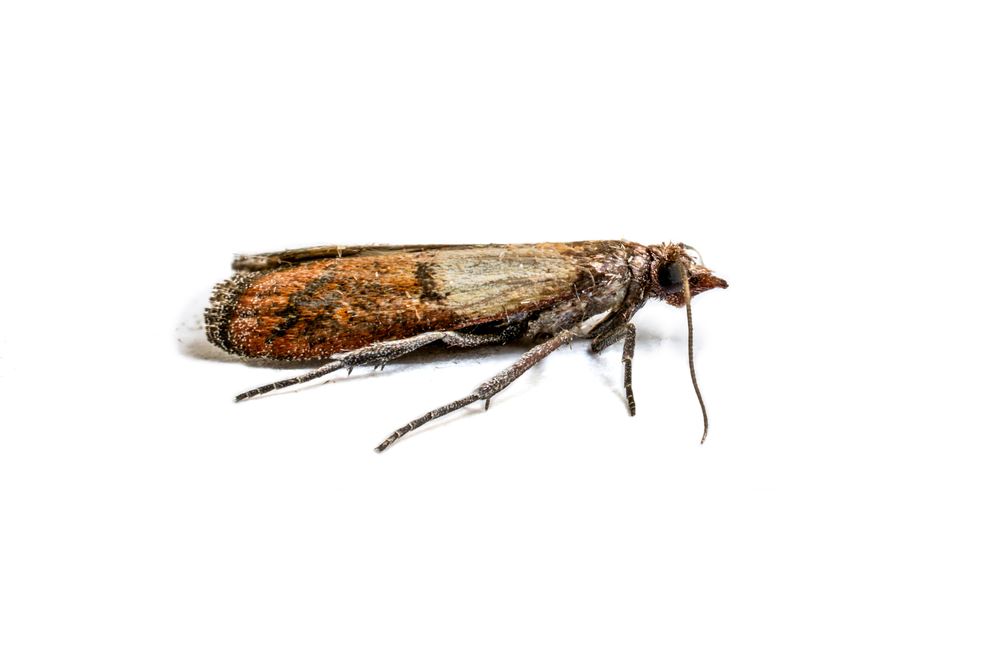Have You Noticed Worms in Your Pantry? You Might Have Pantry Moths!
Pantry moths may seem harmless, but they are not! And we are no stranger to them in the Coastal Empire. Pantry moths are highly destructive, hard-to-control pests that chew through food packaging and weave webs in your food items. Have you ever brought a bag of rice or flour home from the store and opened it to find what looked like a small worm, moth or some webs? That most likely was a pantry moth. Yuck! The truly bad news about these pests is that they can be very difficult to eradicate, especially if they have completed their life cycle and dispersed throughout your pantry. It is important that you act fast before these pests eat through – and lay eggs on – the stored food in your cabinets or pantry.
So what should you do if you have pantry moths in your home? We will get to that, and will provide step-by-step tips to rid your home of pantry moths. But first, let us discuss what pantry moths are, where they come from, what attracts them, and what makes them harmful. If you make it all the way to the end, read on for ways to prevent future pantry moth infestations (Bonus tips from the Pro’s!).
What Are Pantry Moths?
The Pantry moth (P. inerpentella) is one of the several insects known to feed on stored grains and other dried food. They are known by several common names including pantry moth, Indian meal moth, flour moth, weevil moth, and grain moth. This meal moth is very common in the United States, and they stand out from other moths due to their love for stored foods typically found in the cupboard or pantry. Do you now see where they get their common name?
The adult pantry moth is small, measuring only ¼ to 3/8 inch in length with a wingspan of ½ to ¾ inch. Their small size makes them easy to overlook in your kitchen until your storage space is infested by the insects. Pantry moths are grey, brown and tan in color and these pests will literally feed on almost any dry food (include your pet food!). They are known to cause terrible damage to food, spoiling it as it becomes invaded by their larvae.
Where Do Pantry Moths Come From?
Although pantry moths are known to enter your home through doors and windows or openings around vents and cables, they almost always gain entry through purchased dry food items that were contaminated at the food processing or packaging plant or in the bulk bins at the natural food store. Do not lay the blame on an infestation on your poor housekeeping!
Once the female moth has mated, she will find a suitable environment to lay her eggs. Fun and gross fact – the female pantry moth can lay as many as 400 eggs at one time! Ew! But we digress … once the eggs hatch, the larvae feed and grow for several weeks before spinning a pupa (cocoon). The adult moth will emerge from the pupa.
What Attracts Pantry Moths?
The easy answer is pantry items. They are most attracted to items like:
- Flour
- Seeds
- Baking Chocolate
- Teas
- Spices
- Grains
- Nuts
- Rice
- Cake Mixes
- Dog Food
- Dried Beans
- Dried Fruit
- Birdseed
- Herbs
- Bread
Are Pantry Moths Harmful?
There is good news and bad news surrounding pantry moths. We will give you the good before the bad!
- Good news: they are not harmful to people or pets!
- Bad news: they are extremely damaging to your pantry food, leading to a lot of contamination and waste.
Pantry moths cause no physical harm to people or pets; they do not bite or sting or cause any seriously health risks. However, they contaminate your food and when this occurs all affected food should be immediately discarded. Pantry moths are the definition of nuisance pests!
In addition to contaminating your food and causing unnecessary waste, recovering from an infestation can be very time-consuming and expensive. Carefully inspect all food packaging before purchasing it at your local market and once purchased, store dry good in airtight, glass/hard plastic/tin containers.
5 Steps to Rid Your Home of Pantry Moths
1. Empty & inspect
Completely empty out the affected area. Remove every single can, box, bag, and bottle. Inspect the items as you remove them, closely checking for signs of:
- Webs – these may belong to moths and not spiders.
- Larvae – in and on food packaging.
Also keep an eye out for small holes in packaging. Remember that you are pursuing the pantry moths themselves and their larvae. Make sure you check under the lids of jars – moths are known to lay their eggs here. Do not limit your removal and inspection of items to those listed in the table above. Larvae may be tucked into the edges of cans, on spice jars, or even on unopened packages! If you have pets, it is important to check their food too as it is very desirable to pantry moths.
2. Dispose
Dispose of all dry goods with open packaging. Also, discard of any boxes or bags found to have any holes in them that you did not make. Be very thorough as you look over these items: If you have seen even one pantry moth near a certain cupboard or inside your pantry, then – as troubling as it may be – all non-airtight packaging within the area may have been compromised by pests.
Discard all infested foods that you find and if you find larvae on the outside of cans, wipe them down with undiluted vinegar. This will kill the larvae quickly. Dispose of infested items in your outdoor trash can. Do not discard of them in your kitchen trash can as this will do nothing but spread the problem!
If you retain anything from this blog, let it be this: be thorough!
3. Clean EVERYTHING, like you’ve never cleaned before!
By everything, we mean absolutely everything! Give your pantry or dry goods storage cupboard the most thorough cleaning of our life! Use the following cleaning checklist:
- Pull out all of your shelf liners and either wash them or replace them.
- Vacuum the shelves, paying special attention to the corners, undersides, shelf brackets, and mounting hardware.
- Vacuum the walls of the pantry/cupboard, baseboards, trim, floor, ceiling, and door (including the inside edge, hinges, and knob). Removing shelves, if possible, will make this task much easier!
- Wipe down all pantry shelves with a 50/50 solution of vinegar and warm water. If you have any or can get some, add peppermint oil to the mixture. Pantry moths HATE peppermint.
- Mop the floor, using the same 50/50 solution mentioned above.
When you are finished with this intense clean up, remove the vacuum bag outside and dispose of it in your outside trashcan. If you use a bagless vacuum or dust buster, wash out the dust compartment thoroughly so that you do not harbor moth larvae inside the filter.
4. Change storage methods
An easy way to kill pantry moths is cold temperatures! A surefire way to kill current pantry moths and prevent future breeding is to store as many grain and nut products as you can in your fridge or freezer. Keeping these food items out of your pantry will in turn keep pantry moths out. Another suggestion is to store new groceries in a different spot or at least a good distance from your pantry or dry goods cupboard. Both of these can be temporary solutions or permanent strategies, depending on the amount of space you have in cold storage appliances. At a minimum, do this until you have had a chance to monitor the affected pantry to ensure the problem is eliminated.
A permanent solution to prevent pantry moths from breeding is to transfer your grains and other dry food products into mason jars, tins, or other airtight-sealing containers. By doing this, if you inadvertently bring contaminated food home from the market that contains larvae, the moths will not be able to eat through the jar when they hatch. Because of this you will only have that one single jar of food contaminated that will need to be disposed of. This solution is both good for your family and good for the environment!
5. Hold-off on restocking the pantry
This may seem impossible, but it is a super important step to ensure you will not suffer another immediate pantry moth infestation. Wait a few weeks before restocking the area you have now cleaned. When it comes to the aftermath of an infestation, it pays to be patient.
If a few weeks have passed and the problem has not gone away, you can repeat the steps above. When doing so, widen the scope to adjacent areas of your home without going through the hassle and expense of tossing the food you purchased to replace what you had already lost.
Bonus Tips From the Pros: How to Prevent Future Pantry Moth Infestations
Congratulations! You have successfully gotten rid of pantry moths – Yay! Now it is time to take pro-active measures to keep them away!
- Leave peppermint, bay leaves, mint, or cedar chips exposed within the area. If you need to enclose them, place in a small sachet.
- Inspect your cabinets and pantry – and all their contents – on a regular basis. Whenever you spot pantry moths, always act quickly to limit their spread as much as possible. It is much easier to clean a single cabinet than it is to clean every single cabinet in your kitchen!
- Inspect product packaging before purchasing from the store! As mentioned, pantry moths most often hitchhike home with you from the grocery store. Start to really scrutinize the packaging before you buy and leave any suspect packaging right there on the shelf … then book it out of there and journey back to your pest free home!
Although pantry moths are not harmful to your health, they are a huge nuisance and lead to a lengthy and costly clean up. Because they live in and around consumable items, we cannot spray pesticides to get rid of them. However, we can set sticky traps and monitor regularly to ensure the issue is not worsening. If you find pantry moths in your home, give us a call today for some tips from the pros!


